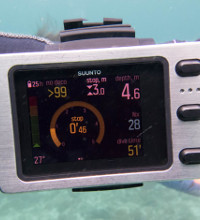Last year, Suunto released the Eon Steel, a completely new computer, designed for advanced and technical divers. With a wide color screen and a different design from the rest of the range, this is clearly a unique product compared to Suunto’s other offerings.
The first look at the Eon Steel is promising: the computer features a nice design and the materials look robust. It’s also quite heavy compared to an average dive computer.
Despite offering pretty advanced functions, getting used to the Eon Steel is pretty straightforward. It has three easy and accessible buttons (even when wearing gloves) and the menu is quite detailed but easy to navigate.
It has a built-in, rechargeable battery and can be charged with a cable that plugs into a USB port. The autonomy lasts between 20 and 40 hours; battery life is displayed on the screen at all times when diving. Divers can also use the USB cable to download the diving data onto DM5, Suunto’s free software.
The Eon Steel uses the same algorithm as other Suunto computers, so on the default setting it is quite conservative. Unlike other models, it has an adjustment that allows users to make it more or less conservative, depending on their diving style. It includes deep stops for added safety, which display on the top of the screen during the dive so you already know at what depth you will have to stop.
Tech specs
All can be found on the Suunto website.
Weight: 12.2 oz. (347 g)
Battery life: 20 to 40 hours
Water resistance: 492 feet (150 m)
Alarms include: tank pressure, deep-stop violation, ceiling violation, dive time, switch gas, gas time, ascent, etc.
Gauge/Air/Nitrox/Trimix/CCR
Monitor multiple tank pressure
The Eon Steel Display
The display is huge. In sunny conditions, I found that the standard brightness was not sufficient in order to get info at a glance. The display can be customized and, for some functions, it is really great; the compass, for example, is big and easy to read. When it comes to some other information, I felt that the computer was not making the most of the large screen — the non-stop time is not as big as it could be; neither is the dive time. The safety or deco stop however features minutes and seconds, and the countdown is big and easy to read.
The dive log display is also pleasant; you can see the entire dive profile and go back and forth during the dive to see depth and time. The original release oddly did not include a no-decompression dive-planning mode; it is now available with version 1.2 of the software. This update also allows switching the display so buttons can be on the left, which is nice for left-handed users.
The downside of having a big screen is the size of the computer itself. Wearing a 5mm wetsuit, I found it to be pretty heavy and bulky, and getting in the way a bit (I am not very tall, and it takes a fair bit of space on my arm). On the upside, it’s not easy to press something by mistake, as it happened only once over a couple of weeks while diving with the computer every day.
The Eon Steel can deal with air, nitrox and trimix, and also has a rebreather mode. I used it only with air and nitrox; it’s quite easy to change the settings and put nitrox in.
Wrap-up

Suunto Eon Steel
- Battery display, long charge life
- Aspect, feel, durability
- Large digital compass
- Free software update
- Deep stops with notice ahead
- Clear dive profiles
- Personal settings flexibility
- Display brightness
- Size and weight with a wetsuit
- Deep stops cannot be turned off
Overall, the Eon Steel is a completely different product from the rest of the Suunto computers. While it may not be appropriate for the beginner diver it is, however, a contender to be taken seriously if you are looking for a top-of-the-range dive computer.

